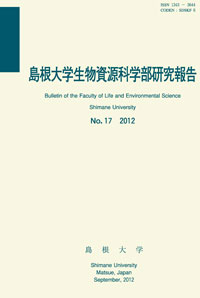島根大学生物資源科学部
ISSN:2435-0885(オンライン)
ISSN:1343-3644(冊子体)
なお、冊子体の刊行は23巻まで
ISSN:1343-3644(冊子体)
なお、冊子体の刊行は23巻まで

ダウンロード数 : ? 件
この文献の参照には次のURLをご利用ください : https://ir.lib.shimane-u.ac.jp/5650
島根大学生物資源科学部研究報告 9
2004-08-31 発行
魚類の水晶体筋収縮に関与するムスカリン性受容体サブタイプの生理学的検討
A pharmacological study of the muscarinic receptors mediating the contraction of teleost lens muscle
藤本 正昭
須山 真由美
山本 純士
ファイル
内容記述(抄録等)
The teleost uses a lens muscle, the retractor lentis, for accommodation to change the distance between the lens and retina. It is innervated by the parasympathetic nerve and regulated with a muscarinic cholinergic receptor. However, the receptor subtype mediating the muscarinic contraction is unknown. In the present work, we examined the subtype in the receptor of the bluegill (Lepomis macrochirus) lens muscle. The enucleated eye was hemisected and the anterior segment was set in a perfusing chamber equipped with two Ag/AgCl electrodes for electrical stimulation. The image of contraction of the lens muscle was displayed on a video screen with a CCD camera via a binocular microscope and simultaneously stored on tape. The degree of contraction was measured directly on the display.
We tested the effect of adiphenine or pirenzepine (M1 subtype antagonists) , gallamine (M2 subtype antagonist) and 4-DAMP (M3 subtype antagonist) on the contraction elicited by carbachol (a nonselective agonist) or electrical stimulation of the nerve in vitro. The muscle contraction was elicited by carbachol or inhibited by these antagonists in a dose-dependent manner. Among the inhibitors, 4-DAMP was the most potent, while the other two antagonists showed about 10-fold weaker effects. From these results, we concluded that the subtype of the muscarinic receptor mediating the contraction of the bluegill lens muscle is M3. The mammalian ciliary muscle has also been reported to have the M3 receptor. It is intriguing that the homologous organ for accommodation both in the mammals and in teleosts has the same muscarinic receptor subtype.
We tested the effect of adiphenine or pirenzepine (M1 subtype antagonists) , gallamine (M2 subtype antagonist) and 4-DAMP (M3 subtype antagonist) on the contraction elicited by carbachol (a nonselective agonist) or electrical stimulation of the nerve in vitro. The muscle contraction was elicited by carbachol or inhibited by these antagonists in a dose-dependent manner. Among the inhibitors, 4-DAMP was the most potent, while the other two antagonists showed about 10-fold weaker effects. From these results, we concluded that the subtype of the muscarinic receptor mediating the contraction of the bluegill lens muscle is M3. The mammalian ciliary muscle has also been reported to have the M3 receptor. It is intriguing that the homologous organ for accommodation both in the mammals and in teleosts has the same muscarinic receptor subtype.
About This Article
Other Article
